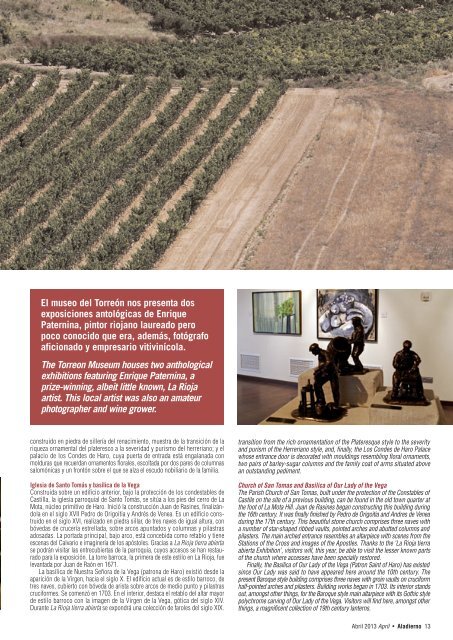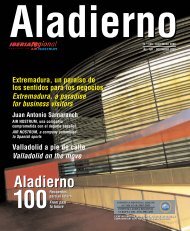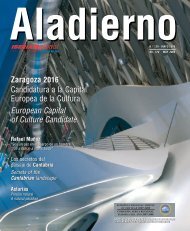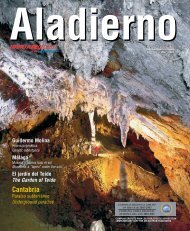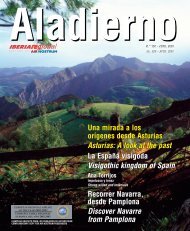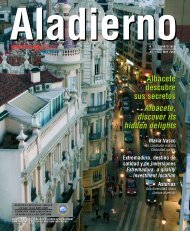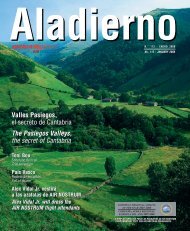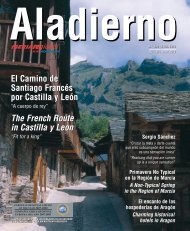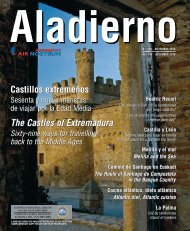You also want an ePaper? Increase the reach of your titles
YUMPU automatically turns print PDFs into web optimized ePapers that Google loves.
El museo del Torreón nos presenta dos<br />
exposiciones antológicas de Enrique<br />
Paternina, pintor riojano laureado pero<br />
poco conocido que era, además, fotógrafo<br />
aficionado y empresario vitivinícola.<br />
The Torreon Museum houses two anthological<br />
exhibitions featuring Enrique Paternina, a<br />
prize-winning, albeit little known, La Rioja<br />
artist. This local artist was also an amateur<br />
photographer and wine grower.<br />
construido en piedra de sillería del renacimiento, muestra de la transición de la<br />
riqueza ornamental del plateresco a la severidad y purismo del herreriano; y el<br />
palacio de los Condes de Haro, cuya puerta de entrada está engalanada con<br />
molduras que recuerdan ornamentos florales, escoltada por dos pares de columnas<br />
salomónicas y un frontón sobre el que se alza el escudo nobiliario de la familia.<br />
Iglesia de Santo Tomás y basílica de la Vega<br />
Construida sobre un edificio anterior, bajo la protección de los condestables de<br />
Castilla, la iglesia parroquial de Santo Tomás, se sitúa a los pies del cerro de La<br />
Mota, núcleo primitivo de Haro. Inició la construcción Juan de Rasines, finalizándola<br />
en el siglo XVII Pedro de Origoitia y Andrés de Venea. Es un edificio construido<br />
en el siglo XVI, realizado en piedra sillar, de tres naves de igual altura, con<br />
bóvedas de crucería estrellada, sobre arcos apuntados y columnas y pilastras<br />
adosadas. La portada principal, bajo arco, está concebida como retablo y tiene<br />
escenas del Calvario e imaginería de los apóstoles. Gracias a La Rioja tierra abierta<br />
se podrán visitar las entrecubiertas de la parroquia, cuyos accesos se han restaurado<br />
para la exposición. La torre barroca, la primera de este estilo en La Rioja, fue<br />
levantada por Juan de Raón en 1671.<br />
La basílica de Nuestra Señora de la Vega (patrona de Haro) existió desde la<br />
aparición de la Virgen, hacia el siglo X. El edificio actual es de estilo barroco, de<br />
tres naves, cubierto con bóveda de arista sobre arcos de medio punto y pilastras<br />
cruciformes. Se comenzó en 1703. En el interior, destaca el retablo del altar mayor<br />
de estilo barroco con la imagen de la Virgen de la Vega, gótica del siglo XIV.<br />
Durante La Rioja tierra abierta se expondrá una colección de faroles del siglo XIX.<br />
transition from the rich ornamentation of the Plateresque style to the severity<br />
and purism of the Herreriano style, and, finally, the Los Condes de Haro Palace<br />
whose entrance door is decorated with mouldings resembling floral ornaments,<br />
two pairs of barley-sugar columns and the family coat of arms situated above<br />
an outstanding pediment.<br />
Church of San Tomas and Basilica of Our Lady of the Vega<br />
The Parish Church of San Tomas, built under the protection of the Constables of<br />
Castile on the site of a previous building, can be found in the old town quarter at<br />
the foot of La Mota Hill. Juan de Rasines began constructing this building during<br />
the 16th century. It was finally finished by Pedro de Origoitia and Andres de Venea<br />
during the 17th century. This beautiful stone church comprises three naves with<br />
a number of star-shaped ribbed vaults, pointed arches and abutted columns and<br />
pilasters. The main arched entrance resembles an altarpiece with scenes from the<br />
Stations of the Cross and images of the Apostles. Thanks to the ‘La Rioja tierra<br />
abierta Exhibition’, visitors will, this year, be able to visit the lesser known parts<br />
of the church where accesses have been specially restored.<br />
Finally, the Basilica of Our Lady of the Vega (Patron Saint of Haro) has existed<br />
since Our Lady was said to have appeared here around the 10th century. The<br />
present Baroque style building comprises three naves with groin vaults on cruciform<br />
half-pointed arches and pilasters. Building works began in 1703. Its interior stands<br />
out, amongst other things, for the Baroque style main altarpiece with its Gothic style<br />
polychrome carving of Our Lady of the Vega. Visitors will find here, amongst other<br />
things, a magnificent collection of 19th century lanterns.<br />
Abril 2013 April • <strong>Aladierno</strong> 13


